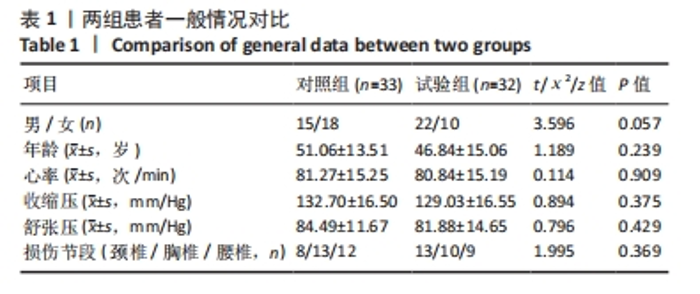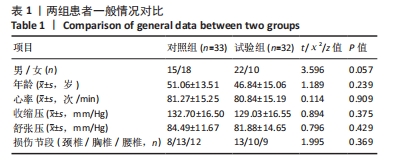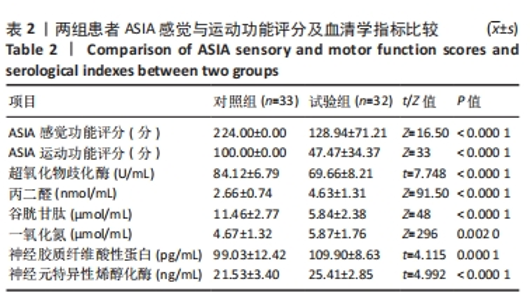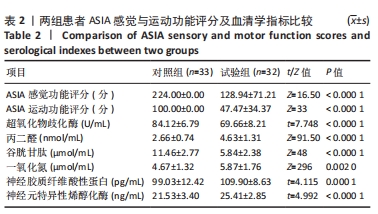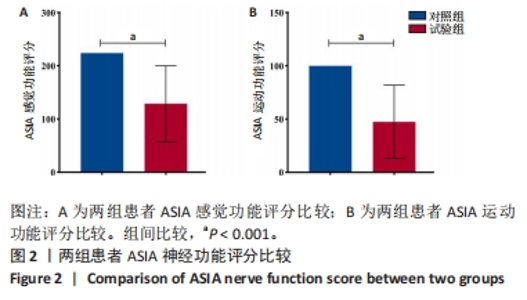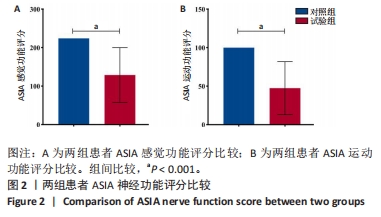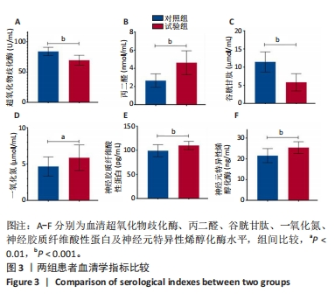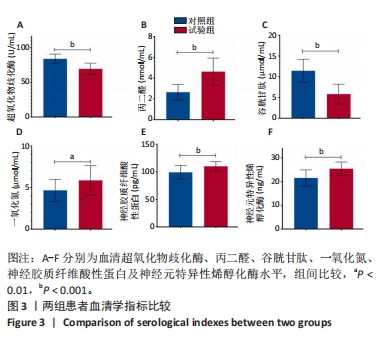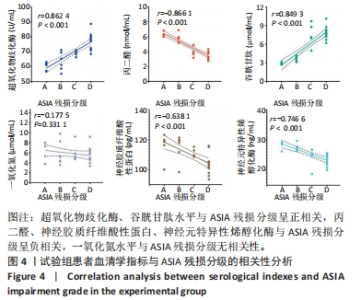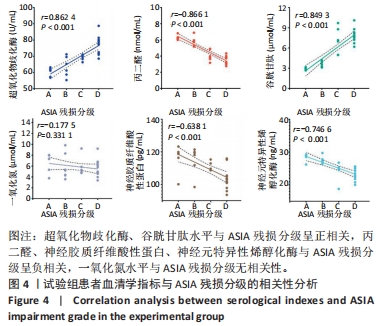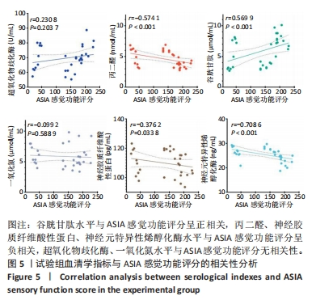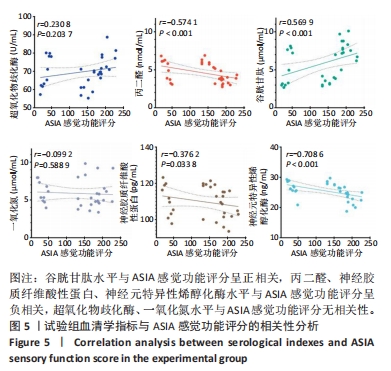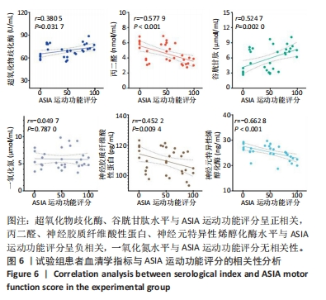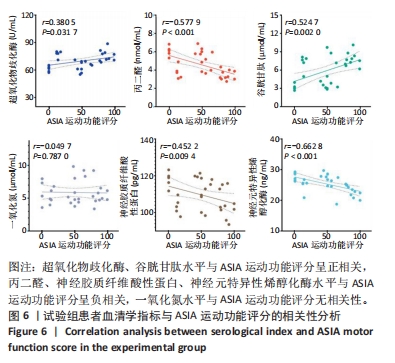Chinese Journal of Tissue Engineering Research ›› 2024, Vol. 28 ›› Issue (34): 5494-5499.doi: 10.12307/2024.594
Previous Articles Next Articles
Correlation between early serum markers and AISA grading in patients with acute spinal cord injury
Wang Yueguang1, Mu Xiaohong2, Jiang Shengyuan2, Deng Bowen2, Kang Ximei1, Su Jianguang1
- 1Chinese Medicine Hospital of Puyang, Puyang 457000, Henan Province, China; 2Dongzhimen Hospital, Beijing University of Chinese Medicine, Beijing 100700, China
-
Received:2023-11-14Accepted:2023-12-14Online:2024-12-08Published:2024-03-14 -
Contact:Mu Xiaohong, MD, Chief physician, Professor, Doctoral supervisor, Dongzhimen Hospital, Beijing University of Chinese Medicine, Beijing 100700, China -
About author:Wang Yueguang, Master, Attending physician, Chinese Medicine Hospital of Puyang, Puyang 457000, Henan Province, China
CLC Number:
Cite this article
Wang Yueguang, Mu Xiaohong, Jiang Shengyuan, Deng Bowen, Kang Ximei, Su Jianguang. Correlation between early serum markers and AISA grading in patients with acute spinal cord injury[J]. Chinese Journal of Tissue Engineering Research, 2024, 28(34): 5494-5499.
share this article
Add to citation manager EndNote|Reference Manager|ProCite|BibTeX|RefWorks
| [1] TANG Y, LIU HL, MIN LX, et al. Serum and cerebrospinal fluid tau protein level as biomarkers for evaluating acute spinal cord injury severity and motor function outcome. Neural Regen Res. 2019;14(5):896-902. [2] TSEHAY Y, WEBER-LEVINE C, KIM T, et al. Advances in monitoring for acute spinal cord injury: a narrative review of current literature. Spine J. 2022;22(8):1372-1387. [3] RICHARD-DENIS A, BEAUSÉJOUR M, THOMPSON C, et al. Early Predictors of Global Functional Outcome after Traumatic Spinal Cord Injury: A Systematic Review. J Neurotrauma. 2018;35(15):1705-1725. [4] ELIZEI SS, KWON BK. The translational importance of establishing biomarkers of human spinal cord injury. Neural Regen Res. 2017;12(3):385-388. [5] OGURCOV S, SHULMAN I, GARANINA E, et al. Blood Serum Cytokines in Patients with Subacute Spinal Cord Injury: A Pilot Study to Search for Biomarkers of Injury Severity. Brain Sci. 2021;11(3):322. [6] 闵令霞,刘宏亮,段霞,等.急性脊髓损伤生物标志物的研究进展[J].中国康复,2021,36(1):45-49. [7] HELLER RA, SEELIG J, CROWELL HL, et al. Predicting neurological recovery after traumatic spinal cord injury by time-resolved analysis of monocyte subsets. Brain. 2021;144(10):3159-3174. [8] LEISTER I, ALTENDORFER B, MAIER D, et al. Trajectory of Serum Levels of Glial Fibrillary Acidic Protein Within Four Weeks Post-Injury Is Related to Neurological Recovery During the Transition from Acute to Chronic Spinal Cord Injury. J Neurotrauma. 2023;40(9-10):999-1006. [9] LIU C, LIU Y, MA B, et al. Mitochondrial regulatory mechanisms in spinal cord injury: A narrative review. Medicine (Baltimore). 2022;101(46):e31930. [10] 缪鑫,林俊卿,郑宪友.线粒体功能障碍在脊髓损伤中的作用及相关治疗研究进展[J].中国修复重建外科杂志,2022,36(7):902-907. [11] MCEWEN ML, SULLIVAN PG, RABCHEVSKY AG, et al. Targeting mitochondrial function for the treatment of acute spinal cord injury. Neurotherapeutics. 2011;8(2):168-179. [12] WANG Y, JIAO J, ZHANG S, et al. RIP3 inhibition protects locomotion function through ameliorating mitochondrial antioxidative capacity after spinal cord injury. Biomed Pharmacother. 2019;116:109019. [13] KHAING ZZ, CHEN JY, SAFARIANS G, et al. Clinical Trials Targeting Secondary Damage after Traumatic Spinal Cord Injury. Int J Mol Sci. 2023;24(4):3824. [14] 曹烈虎,牛丰,张文财,等.创伤性脊柱脊髓损伤康复治疗专家共识(2020版)[J].中华创伤杂志,2020,36(5):385-392. [15] KIRSHBLUM S, BOTTICELLO A, BENEDETTO J, et al. A Comparison of Diagnostic Stability of the ASIA Impairment Scale Versus Frankel Classification Systems for Traumatic Spinal Cord Injury. Arch Phys Med Rehabil. 2020;101(9):1556-1562. [16] KIRSHBLUM S, SNIDER B, EREN F, et al. Characterizing Natural Recovery after Traumatic Spinal Cord Injury. J Neurotrauma. 2021;38(9):1267-1284. [17] 胥勇,王太平,刘信.不同AISA分级急性脊髓创伤患者血清炎症因子和脑脊液生化指标的变化及其临床意义[J].中国现代医学杂志,2023, 33(6):49-54. [18] 孙大兵,周晓哲,高文山.急性脊髓损伤血清和脑脊液生物标志物的研究进展[J].中国脊柱脊髓杂志,2019,29(6):568-572. [19] YANG H, ZHANG P, XIE M, et al. Parallel Metabolomic Profiling of Cerebrospinal Fluid, Plasma, and Spinal Cord to Identify Biomarkers for Spinal Cord Injury. J Mol Neurosci. 2022;72(1):126-135. [20] SCHADING S, EMMENEGGER TM, FREUND P. Improving Diagnostic Workup Following Traumatic Spinal Cord Injury: Advances in Biomarkers. Curr Neurol Neurosci Rep. 2021;21(9):49. [21] ALBAYAR AA, ROCHE A, SWIATKOWSKI P, et al. Biomarkers in Spinal Cord Injury: Prognostic Insights and Future Potentials. Front Neurol. 2019;10:27. [22] DU W, LI H, SUN J, et al. The Prognostic Value of Serum Neuron Specific Enolase (NSE) and S100B Level in Patients of Acute Spinal Cord Injury. Med Sci Monit. 2018;24:4510-4515. [23] KUHLE J, GAIOTTINO J, LEPPERT D, et al. Serum neurofilament light chain is a biomarker of human spinal cord injury severity and outcome. J Neurol Neurosurg Psychiatry. 2015;86(3):273-279. [24] BIGLARI B, SWING T, CHILD C, et al. A pilot study on temporal changes in IL-1β and TNF-α serum levels after spinal cord injury: the serum level of TNF-α in acute SCI patients as a possible marker for neurological remission. Spinal Cord. 2015;53(7):510-514. [25] 张勇,申才良,董福龙,等.颈部脊髓损伤患者24h内外周血中细胞因子水平与ASIA功能分级的相关性:对照组比较[J].中国组织工程研究, 2018,22(24):3824-3830. [26] 张焱,郝剑,李波,等.氧化应激在脊髓损伤中的研究进展[J].中华实验外科杂志,2018,35(6):1184-1189. [27] CHIO J, PUNJANI N, HEJRATI N, et al. Extracellular Matrix and Oxidative Stress Following Traumatic Spinal Cord Injury: Physiological and Pathophysiological Roles and Opportunities for Therapeutic Intervention. Antioxid Redox Signal. 2022;37(1-3):184-207. [28] LEISTER I, ALTENDORFER B, MAIER D, et al. Serum Levels of Glial Fibrillary Acidic Protein and Neurofilament Light Protein Are Related to the Neurological Impairment and Spinal Edema after Traumatic Spinal Cord Injury. J Neurotrauma. 2021;38(24):3431-3439. [29] KWON BK, STREIJGER F, FALLAH N, et al. Cerebrospinal Fluid Biomarkers To Stratify Injury Severity and Predict Outcome in Human Traumatic Spinal Cord Injury. J Neurotrauma. 2017;34(3):567-580. [30] PARAGOND S, DHATT SS, KUMAR V, et al. Prognosticating acute traumatic spinal cord injury using Neurofilament (NF), Neuron Specific Enolase (NSE), Matrix Metalloproteinases (MMPs), and S-100B as biomarkers. Ir J Med Sci. 2023. doi: 10.1007/s11845-023-03476-6. [31] WICHMANN TO, KASCH H, DYRSKOG S, et al. Glial fibrillary acidic protein is a robust biomarker in cerebrospinal fluid and peripheral blood after traumatic spinal cord injury: a prospective pilot study. Acta Neurochir (Wien). 2023;165(6):1417-1425. [32] TARDIVO V, CROBEDDU E, PILLONI G, et al. Say “no” to spinal cord injury: is nitric oxide an option for therapeutic strategies? Int J Neurosci. 2015; 125(2):81-90. [33] HOSAKA N, KIMURA S, YAMAZAKI A, et al. Significant correlation between cerebrospinal fluid nitric oxide concentrations and neurologic prognosis in incomplete cervical cord injury. Eur Spine J. 2008;17(2):281-286. [34] 苏畅.PI3-K/Akt通路介导野蔷薇苷对抗急性缺氧性脑水肿及血管内皮细胞损伤的机制研究[D].石家庄: 河北医科大学,2016. [35] 李宾,于德水.人羊膜间充质干细胞移植对脊髓损伤大鼠诱导型一氧化氮合酶表达的影响[J].中国急救医学,2020,40(8):772-776. |
| [1] |
Song Jiating, Chen Jianmin, Wang Kewen, Huang Lanying, Xu Senming, Gui Yuchang, Xu Jianwen.
Metabolomics analysis of serum and urine in patients with traumatic spinal cord injury #br#
#br#
[J]. Chinese Journal of Tissue Engineering Research, 2024, 28(在线): 1-6.
|
| [2] | Yang Yifeng, Ye Nan, Wang Lin, Guo Shuaicheng, Huang Jian. Signaling pathway of dexmedetomidine against ischemia-reperfusion injury [J]. Chinese Journal of Tissue Engineering Research, 2024, 28(9): 1464-1469. |
| [3] | Lou Guo, Zhang Yan, Fu Changxi. Role of endothelial nitric oxide synthase in exercise preconditioning-induced improvement of myocardial ischemia-reperfusion injury [J]. Chinese Journal of Tissue Engineering Research, 2024, 28(8): 1283-1288. |
| [4] | Zhang Xiaoyun, Liu Hua, Chai Yuan, Chen Feng, Zeng Hao, Gao Zhengang, Huang Yourong. Effect of Yishen Gushu Formula on bone metabolic markers and clinical efficacyn in patients with osteoporosis of kidney deficiency and blood stasis type [J]. Chinese Journal of Tissue Engineering Research, 2024, 28(8): 1155-1160. |
| [5] | Pan Xiaolong, Fan Feiyan, Ying Chunmiao, Liu Feixiang, Zhang Yunke. Effect and mechanism of traditional Chinese medicine on inhibiting the aging of mesenchymal stem cells [J]. Chinese Journal of Tissue Engineering Research, 2024, 28(7): 1091-1098. |
| [6] | Feng Ruiqin, Han Na, Zhang Meng, Gu Xinyi, Zhang Fengshi. Combination of 1% platelet-rich plasma and bone marrow mesenchymal stem cells improves the recovery of peripheral nerve injury [J]. Chinese Journal of Tissue Engineering Research, 2024, 28(7): 985-992. |
| [7] | Bu Xianzhong, Bu Baoxian, Xu Wei, Zhang Chi, Zhang Yisheng, Zhong Yuanming, Li Zhifei, Tang Fubo, Mai Wei, Zhou Jinyan. Analysis of serum differential proteomics in patients with acute cervical spondylotic radiculopathy [J]. Chinese Journal of Tissue Engineering Research, 2024, 28(4): 535-541. |
| [8] | Dong Gengxin, Li Yiting, Hong Yinglu, Bao Dapeng. Effect of hydrogen-rich gas on proprioception and muscle endurance after high-intensity exercise [J]. Chinese Journal of Tissue Engineering Research, 2024, 28(34): 5413-5418. |
| [9] | Bu Xianzhong, Zhong Yuanming, Bu Baoxian, Li Jitian, Wang Lihe, Li Huiying, Yang Hanli, Xu Wei. Serum differential proteomic analysis of developmental cervical canal stenosis [J]. Chinese Journal of Tissue Engineering Research, 2024, 28(34): 5432-5439. |
| [10] | Song Jiating, Chen Jianmin, Wang Kewen, Huang Lanying, Xu Senming, Gui Yuchang, Xu Jianwen. Metabolomics analysis of serum and urine in patients with traumatic spinal cord injury [J]. Chinese Journal of Tissue Engineering Research, 2024, 28(32): 5085-5090. |
| [11] | Lu Xiaoling, Liu Bin, Xu Bin. Bioinformatics identification and validation of genes related to fatty acid metabolism in rheumatoid arthritis [J]. Chinese Journal of Tissue Engineering Research, 2024, 28(32): 5116-5121. |
| [12] | Ren Weiliang, Jiao Yongwei, Zhang Jian, Yang Liying, Yang Qi. Modulatory effect of resveratrol on oxidative stress and inflammatory factors in the joint fluid of rats with knee osteoarthritis [J]. Chinese Journal of Tissue Engineering Research, 2024, 28(32): 5154-5158. |
| [13] | Song Wenxue, Liao Yidong, Ming Jiang, He Longcai, Chen Guangtang, Chen Chen, Wang Zili, Xiong Mingsong, Cui Junshuan, Xu Kaya. Intracranial transplantation of human bone marrow mesenchymal stem cells alleviates rat brain ischemia-reperfusion injury [J]. Chinese Journal of Tissue Engineering Research, 2024, 28(31): 5036-5041. |
| [14] | Li Yue, Qiao Hua. miRNA derived from mesenchymal stem cells and its derivatives in treatment of pathological scar [J]. Chinese Journal of Tissue Engineering Research, 2024, 28(31): 5042-5047. |
| [15] | Cao Sheng, Kong Lingwei, Xu Kun, Sun Zhijie. Effect of gelatin methacryloyl hydrogel loaded with salvianolic acid B on intervertebral disc degeneration [J]. Chinese Journal of Tissue Engineering Research, 2024, 28(3): 380-386. |
| Viewed | ||||||
|
Full text |
|
|||||
|
Abstract |
|
|||||


